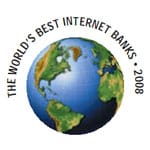BEST INTERNET BANKS 2008
In the second of a two-part series, Global Finance identifies the best corporate/institutional and consumer Internet banks globally and in six regions.

Leading banks such as Bank of America, Citi, Garanti, HSBC, Standard Chartered and Wells Fargo are adding new clients from the next generation and in growing markets, building deeper relationships with existing customers, gathering deposits, generating payment and trading revenue, and cross-selling products through their Internet initiatives.
They are also still finding big savings from cutting processing and servicing costs. For example, HSBC recently announced that its $6 billion global initiative to move its far-flung banking systems, including more than 40 web banking systems, onto one global platform has paid for itself midway through the effort, scheduled for 2011 completion. Uniting the systems has allowed HSBC to reduce staffing costs for processing transactions among platforms.
Top online banks are adapting to changing web technology, applications, business models and competition. They are responding to customers’ evolving, demanding expectations for customized, data-intensive applications they can access anytime anywhere. For example, Citi—named overall global winner and best corporate/institutional Internet bank globally and in several regions—has integrated new mobile Internet banking applications strategically into its international growth plans. “Citi is committed to providing our customers with solutions that enable them to interact with their bank wherever they are and however they choose—in person, online, while in transit or on their mobile phone,” says Deborah Hopkins, chief innovation officer at Citi. The financial giant formed Mobile Money Ventures with SK Telecom to create a common, global mobile financial services platform.
Citi says MMV is one of many innovative web initiatives it is launching around the world. Citi is also introducing products and services for customers who commute via public transit, manage their money online and are seeking a more convenient retail-branch experience.
Future Concerns
Banks are having to constantly innovate, analysts say, because standing still will lead to losing business to other banks and non-banks that are giving today’s consumers and business users what they seek. Many banks have much work left to do in this area. “While consumer expectations advance at a fast pace, a gap between consumer expectations and bank delivery grows,” according to a new report from Boston–based research firm Celent. The firm also issued a similar report about wholesale banking last year. “Without a change in strategy, this delivery gap will widen and threaten the bottom line,” Celent warns.
Celent defines Web 2.0 as “the tipping point in the evolution of the Internet, where consumer behavior and its enabling technology emphasize the Internet user experience and capabilities as engaging, interactive and collaborative.” The firm argues that Web 2.0 represents a vastly different approach from the Internet’s traditional one-way communication and static, unconnected data, which is where too many banks’ online initiatives still reside.
Adam Rombel



